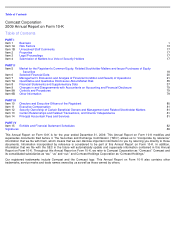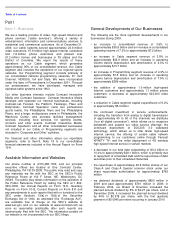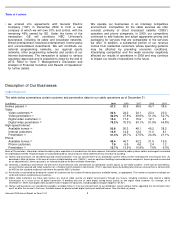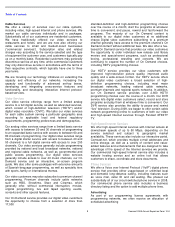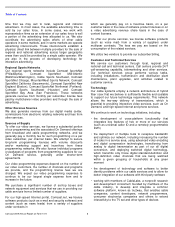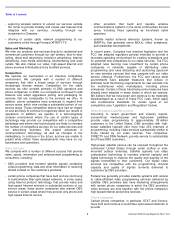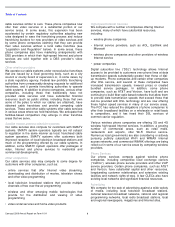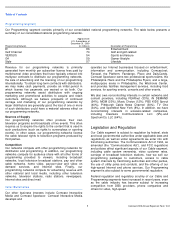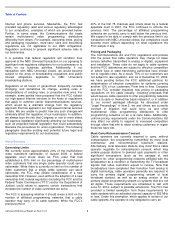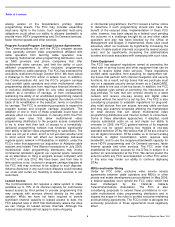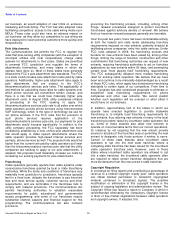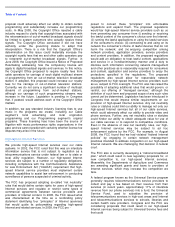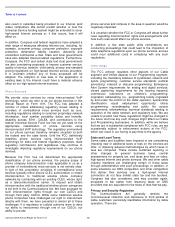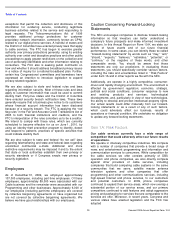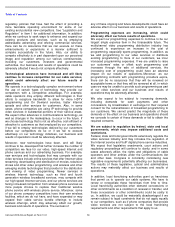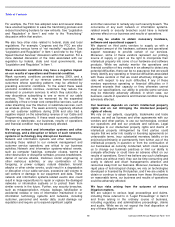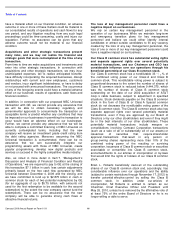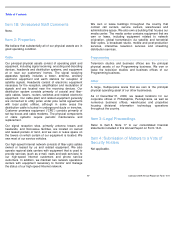Comcast 2009 Annual Report Download - page 13
Download and view the complete annual report
Please find page 13 of the 2009 Comcast annual report below. You can navigate through the pages in the report by either clicking on the pages listed below, or by using the keyword search tool below to find specific information within the annual report.
Table of Contents
Comcast 2009 Annual Report on Form 10-K
8
Internet and phone services. Meanwhile, the FCC has
provided regulatory relief and various regulatory advantages
to our competitors, examples of which are provided below.
Further, in some areas, the Communications Act treats
certain multichannel video programming distributors
differently from others. For example, ownership limits, pricing
and packaging regulation, must-carry rules and franchising
regulations are not applicable to our DBS competitors.
Regulation continues to present significant adverse risks to
our businesses.
It is possible that federal regulators will condition their
approval of the NBC Universal transaction on our agreeing to
significant new regulatory obligations for our businesses or to
limits on our business activities. Additionally, if our
transaction with NBC Universal closes, we would become
subject to the array of broadcasting regulations and public
interest obligations applicable to NBC Universal’s
broadcasting stations.
Regulators at all levels of government frequently consider
changing, and sometimes do change, existing rules or
interpretations of existing rules, or prescribe new ones. For
example, some parties have proposed that the FCC subject
our high-speed Internet services to the kinds of regulations
that apply to common carrier telecommunications services,
which would be a dramatic change from the regulatory
approach that has applied to our high-speed Internet services
to date. We are unable to predict how any such changes will
ultimately affect the regulation of our businesses. In addition,
we always face the risk that Congress or one or more states
will approve legislation significantly affecting our businesses,
such as proposed federal legislation that could substantially
liberalize the procedures for union organization. The following
paragraphs describe existing and potential future legal and
regulatory requirements for our businesses.
Video Services
Ownership Limits
We currently serve approximately 24% of the multichannel
video customers nationwide. In August 2009, a federal
appellate court struck down an FCC order that had
established a 30% limit on the percentage of multichannel
video customers that any single cable operator could serve
nationwide. While there is currently no limit on the number of
video customers that a single cable operator can serve
nationwide, the FCC may initiate consideration of a new
ownership limit. However, even without the adoption of a new
ownership limit, federal regulators (including the FCC and the
Federal Trade Commission (“FTC”) and/or the Department of
Justice) could refuse to approve certain transactions that
increase the number of video customers we serve.
The FCC is assessing whether it should revise a limit on the
number of affiliated programming networks that a cable
operator may carry on its cable systems. While the FCC’s
previous limit of
40% of the first 75 channels was struck down by a federal
appellate court in 2001, the FCC continues to enforce the
previous limit. The percentage of affiliated programming
networks we currently carry is well below the previous limit.
We expect to be able to comply with the previous limit if our
transaction with NBC Universal closes, but compliance could
become more difficult depending on what regulations the
FCC adopts, if any.
Pricing and Packaging
The Communications Act and FCC regulations and policies
limit the prices that cable operators may charge for basic
service (whether transmitted in analog or digital), equipment
and installation. These rules do not apply to cable systems
that the FCC determines are subject to effective competition
or where local or state franchising authorities have chosen
not to regulate rates. As a result, 75% of our customers are
not subject to rate regulation, and, as of December 31, 2009,
we have pending before the FCC additional petitions for
determination of effective competition for systems covering
another 12% of our customers. From time to time, Congress
and the FCC consider imposing new pricing or packaging
regulations on the cable industry, including proposals that
would require cable operators to offer programming networks
on an a la carte or themed-tier basis instead of, or in addition
to, our current packaged offerings. As discussed under
“Legal Proceedings” in Item 3, we and others are currently
involved in litigation that could force us and other
multichannel video programming distributors to offer
programming networks on an a la carte basis. Additionally,
uniform pricing requirements under the Communications Act
may affect our ability to respond to increased competition
through offers that aim to retain existing customers or regain
those we have lost.
Must-Carry/Retransmission Consent
Cable operators are currently required to carry, without
compensation, the programming transmitted by most local
commercial and noncommercial television stations.
Alternatively, local television stations may insist that a cable
operator negotiate for retransmission consent, which may
enable popular stations to demand cash payments or other
significant concessions (such as the carriage of, and
payment for, other programming networks affiliated with the
broadcaster) as a condition of transmitting the TV broadcast
signals that video customers expect to receive. Now that
broadcasters have completed their transition from analog to
digital technology, cable operators generally are required to
carry the primary digital programming stream of local
broadcast stations, as well as an analog version of the
primary digital programming stream on systems that are not
all digital. These requirements are scheduled to last until
June 12, 2012, subject to possible extensions. The FCC has
provided a limited exemption from these requirements for
cable systems with an activated channel capacity of 552 MHz
or less. Under this exemption, which applies to certain of our
cable systems, the operator is only obligated to carry an



